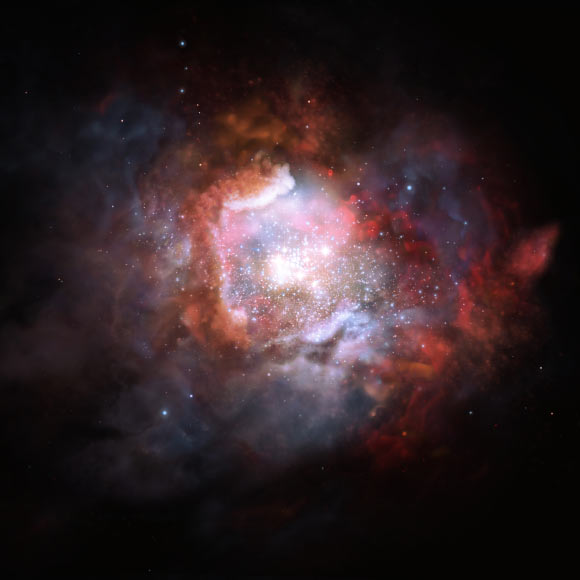Two independent teams of astronomers have discovered that both starburst galaxies in the early Universe and a star-forming region in a nearby galaxy called the Large Magellanic Cloud contain a much higher proportion of massive stars than is found in more peaceful galaxies. The findings, detailed in a pair of papers published in the journals Nature and Science, challenge current ideas about how galaxies evolved.

An artist’s impression of a starburst galaxy. This kind of galaxy is typically forming stars at such a high rate; they can form up to 1,000 times more stars per year, compared to our own Milky Way Galaxy. Image credit: M. Kornmesser / ESO.
One of the two teams, led by Dr. Zhi-Yu Zhang from the University of Edinburgh, used the Atacama Large Millimeter/submillimeter Array (ALMA) to investigate the proportion of massive stars in four distant, dust-shrouded starburst galaxies.
These galaxies are seen when the Universe was much younger than it is now so the infant galaxies are unlikely to have undergone many previous episodes of star formation, which might otherwise have confused the results.
Dr. Zhang and colleagues developed a new technique — analogous to radiocarbon dating — to measure the abundances of different types of carbon monoxide in the four starburst galaxies.
They observed the ratio of two types of carbon monoxide containing different isotopes.
“Carbon and oxygen isotopes have different origins,” Dr. Zhang said.
“18O is produced more in massive stars, and 13C is produced more in low- to intermediate-mass stars.”
Thanks to the new technique the team was able to peer through the dust in these galaxies and assess for the first time the masses of their stars.
The mass of a star is the most important factor determining how it will evolve.
“The ratio of 18O to 13C was about 10 times higher in these starburst galaxies in the early Universe than it is in galaxies such as the Milky Way, meaning that there is a much higher proportion of massive stars within these starburst galaxies,” said team member Dr. Donatella Romano, from the INAF-Astrophysics and Space Science Observatory in Bologna, Italy.
The ALMA finding is consistent with another discovery in the local Universe.
A research team led by University of Oxford astronomer Dr. Fabian Schneider used ESO’s Very Large Telescope to observe nearly 1,000 stars in 30 Doradus (also known as the Tarantula Nebula) — a star-forming region in the Large Magellanic Cloud, a small satellite galaxy to our Milky Way.
They used detailed analyses of about 250 stars with masses between 15 and 200 times the mass of our Sun to determine the distribution of stellar ages and initial masses in the region.
“We found around 30% more stars with masses more than 30 times that of the Sun than expected, and about 70% more than expected above 60 solar masses,” Dr. Schneider said.
“Our results challenge the previously predicted 150 solar mass limit for the maximum birth mass of stars and even suggest that stars could have birth masses up to 300 solar masses.”
“Our findings lead us to question our understanding of cosmic history,” added Dr. Rob Ivison, an astronomer at ESO and the University of Edinburgh and a co-author of the Nature paper.
“Astronomers building models of the Universe must now go back to the drawing board, with yet more sophistication required.”
_____
Zhi-Yu Zhang et al. 2018. Stellar populations dominated by massive stars in dusty starburst galaxies across cosmic time. Nature 558: 260-263; doi: 10.1038/s41586-018-0196-x
F.R.N. Schneider et al. 2018. An excess of massive stars in the local 30 Doradus starburst. Science 359 (6371): 69-71; doi: 10.1126/science.aan0106







